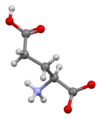Origin of life facts for kids
The origin of life on Earth is a big scientific puzzle that isn't fully solved yet. Many ideas exist, but there are only a few clear facts.
Most experts believe that all life we see today evolved from one very early life form. We don't know exactly how this first life form appeared. Scientists think it was a natural process that happened about 3.9 billion years ago.
A main question is whether the way living things get energy (metabolism) came first, or if the way they pass on information (genetics) came first. The RNA world hypothesis suggests genetics came first. The protein world hypothesis suggests metabolism came first.
Another big puzzle is how cells developed. Cells are like tiny, self-contained factories. A cell membrane is very important because it keeps all the chemicals needed for life together in one place.
Contents
Earliest Signs of Life
Orange labels: known ice ages.
Also see: Human timeline and Nature timeline
Ancient Microfossils
The oldest signs of life found are tiny fossilized living things called microorganisms. These microfossils were found in rocks in Quebec, Canada. These rocks are from ancient underwater hot springs.
These rocks are incredibly old, about 4.28 billion years old. The tiny tube-like shapes found in them suggest that life might have appeared almost immediately after Earth's oceans formed, around 4.4 billion years ago. If life started so quickly on Earth, it might mean life is common in the universe!
Older Discoveries
Before this discovery, scientists thought that stromatolites were the oldest known life forms. Stromatolites are layered rocks formed by tiny living things called cyanobacteria. Fossils of these stromatolites, found in Australia, are 3.45 billion years old. This meant life likely started between 4.4 billion years ago (when water first became liquid) and 3.5 billion years ago.
Even older evidence comes from rocks in Greenland. Scientists found a lot of a lighter type of carbon there. Living things prefer to use lighter carbon because it takes less energy. This "fingerprint" of lighter carbon is preserved in the rocks. This suggests that life might have existed on Earth as early as 3.85 billion years ago.
Some scientists also think that life might have traveled from one planet to another as tiny spores. This idea is called panspermia.
How Scientists Studied Life's Start
No Spontaneous Generation
For a long time, people believed that living things could just appear from non-living matter. This was called "spontaneous generation." But in the 1800s, Louis Pasteur proved this wrong. He showed that bacteria and viruses only grow on sterile material if spores are already present.
Darwin's Idea
In 1871, Charles Darwin suggested a natural way life could have started. He imagined a "warm little pond" filled with chemicals, heat, and electricity. In this pond, protein-like compounds could have formed and become more complex. He also noted that today, such new life would be eaten right away, but this wouldn't have happened before other living things existed.
The "Primordial Soup"
In 1924, Alexander Oparin had an important idea. He said that Earth's early atmosphere had no oxygen. Without oxygen, sunlight could have created a "primordial soup" of organic molecules. These molecules are the building blocks of life. Oparin thought these molecules would combine, grow into droplets, and even "reproduce" by splitting. This would be a very basic form of metabolism. Many modern ideas about life's origin still use Oparin's "primordial soup" as a starting point.
Around the same time, J.B.S. Haldane also suggested that early oceans were a "hot dilute soup." In this soup, organic compounds could have formed. He called this process biopoiesis, meaning living matter evolving from non-living molecules that could copy themselves.
Earth's Early Environment
There are almost no rocks left from before 3.8 billion years ago. The early Earth was a very harsh place. Between 3.8 and 4.1 billion years ago, Earth experienced the "Late Heavy Bombardment." This was a time when many asteroids and comets crashed into Earth and other planets. These impacts would likely have killed any life that existed at that time.
Scientists also look at the chemicals inside cells for clues about early Earth's oceans. Cells today have much more potassium, phosphate, and certain metals than modern oceans. This suggests that the first cells might have formed in inland pools near hot springs, which had a chemical makeup similar to what's inside cells.
Temperature and Time
If life started deep in the ocean near hot vents, it could have begun as early as 4 to 4.2 billion years ago. If it started on the surface, it likely happened between 3.5 and 4 billion years ago.
Scientists think that the development of early life, from simple molecules to more complex organisms, could have happened quite quickly, perhaps in just a few million years.
Earth's Changing Air
Originally, Earth's atmosphere had almost no free oxygen. It slowly changed over billions of years to what it is today. This change began with cyanobacteria, which were the first living things to make free oxygen through photosynthesis. Most living things today need oxygen, but the first organisms probably did not. They were "anaerobic," meaning they lived without oxygen.
How Life Might Have Started
There isn't one "standard model" for how life began, but most accepted ideas are based on what we know about tiny molecules and cells.
Here's a common idea of the steps:
- Step 1: Simple Molecules Form. Under the right conditions, basic small molecules, like amino acids, are created. The Miller–Urey experiment in 1953 showed how this could happen. We now know these building blocks are common even in space.
- Step 2: Building Blocks Join Up. These small molecules then join together to form larger, more complex molecules.
- Step 3: Self-Copying Molecules. Some molecules, like RNA, might have been able to copy themselves. This is the idea behind the RNA world hypothesis.
- Step 4: Cells Develop. Eventually, these molecules would have been enclosed within a membrane, forming the first simple cells.
The basic chemicals thought to have formed life include:
- Methane (CH4)
- Ammonia (NH3)
- Water (H2O)
- Hydrogen sulfide (H2S)
- Carbon dioxide (CO2) or carbon monoxide (CO)
- Phosphate (PO43-)
There was very little or no oxygen in the early atmosphere.
Where Organic Molecules Came From
Organic molecules are the carbon-based building blocks of life. There are three main ways they could have appeared on early Earth:
- From Energy: Energy sources like ultraviolet light from the sun or lightning could have created them.
- From Space: Objects like meteorites crashing into Earth could have delivered them.
- From Impacts: The shock from these impacts could have also created organic molecules.
Scientists believe that the heavy bombardment of Earth by space objects before 3.5 billion years ago brought a lot of organic material, similar to what other energy sources produced.
Miller-Urey Experiment
In 1953, Stanley Miller and Harold Urey did a famous experiment. They showed how organic molecules could form on early Earth from non-living chemicals. They used a mixture of gases like methane, ammonia, and hydrogen, which were thought to be in Earth's early atmosphere. This experiment successfully created basic organic molecules, including amino acids. We now know that for more than half of Earth's history, its atmosphere had almost no oxygen.
Fox's Experiments
Later, Sidney W. Fox showed that amino acids could naturally form small chains called peptides. These peptides could then form tiny spheres with membranes, similar to early cells.
Special Ideas for Life's Start
Some scientists have suggested special conditions that might have made it easier for cells to form.
Clay World Idea
One idea is that complex organic molecules grew slowly on clay surfaces. Clay crystals might have acted as a platform, helping these molecules to organize and grow.
Deep-Hot Biosphere Idea
Another idea, from Thomas Gold, suggests that life first developed deep below Earth's surface, not on the surface. Tiny living things called nanobes, found deep in rocks, might support this idea. It's known that microbial life, like extremophile archaea, lives several kilometers below the surface today.
Gold thought that a constant trickle of food from deep inside Earth, like methane from the Earth's mantle, would be needed for life to survive.
Self-Organization
Living systems are known for their ability to self-organize and self-replicate (make copies of themselves). Even non-living molecules can show these features under the right conditions. Some scientists believe that simple inorganic matter, which could self-organize and perform basic chemical reactions, might have been the very first step towards life.
Main Theories
RNA World Hypothesis
This idea suggests that RNA molecules were the first important molecules for life. RNA could both store genetic information (like DNA) and act as enzymes (which speed up chemical reactions). Later, DNA took over the job of storing genetic information, and proteins became the main enzymes.
Evidence for this idea includes:
- Some RNA molecules still act as enzymes today.
- Some viruses use RNA for their genetic material.
- Many very old and basic parts of cells still rely on RNA.
Metabolism First Hypothesis
This idea suggests that proteins, acting as enzymes, came first and started the basic chemical reactions (metabolism). After that, DNA and RNA developed to store genetic information.
Evidence for this includes:
- Proteins are essential enzymes for all life today.
- Amino acids (the building blocks of proteins) can form from simple chemicals, as shown in the Miller-Urey experiment.
However, a challenge for this idea is that proteins cannot easily copy themselves.
Lipids First Hypothesis
This idea suggests that membranes made of lipids (fats) formed very early. Once organic chemicals were enclosed within these membranes, more complex chemical reactions could happen inside, leading to the development of cells.
Panspermia: Life from Space?
This idea, suggested by Svante Arrhenius and developed by Fred Hoyle, proposes that life didn't start on Earth. Instead, it developed somewhere else in the universe and arrived on Earth as tiny spores, perhaps carried by meteorites. This theory doesn't explain how life began, but rather how it might have spread.
Some scientists even think that early Mars might have been a better place for life to start than early Earth. This is because certain minerals needed for forming genetic material, like RNA, were more common on Mars.
Related pages
Images for kids
-
The Cat's Paw Nebula is a cloud of gas and dust in our Milky Way Galaxy. Green areas show where hot stars make large molecules glow. (Spitzer Space Telescope, 2018)
-
The earliest signs of life are tiny fossils found near white smoker hydrothermal vents. They might have lived as early as 4.28 billion years ago, soon after Earth's oceans formed.
-
Many molecules in living things, like this L-glutamic acid, have a specific "handedness." This is a puzzle for scientists studying how life began.
-
Stromatolites in Glacier National Park, dated 3.5 billion years ago, are among the earliest signs of life.
-
Modern stromatolites in Shark Bay, Australia, are still being formed today by tiny photosynthetic bacteria.
See also
 In Spanish: Abiogénesis para niños
In Spanish: Abiogénesis para niños








